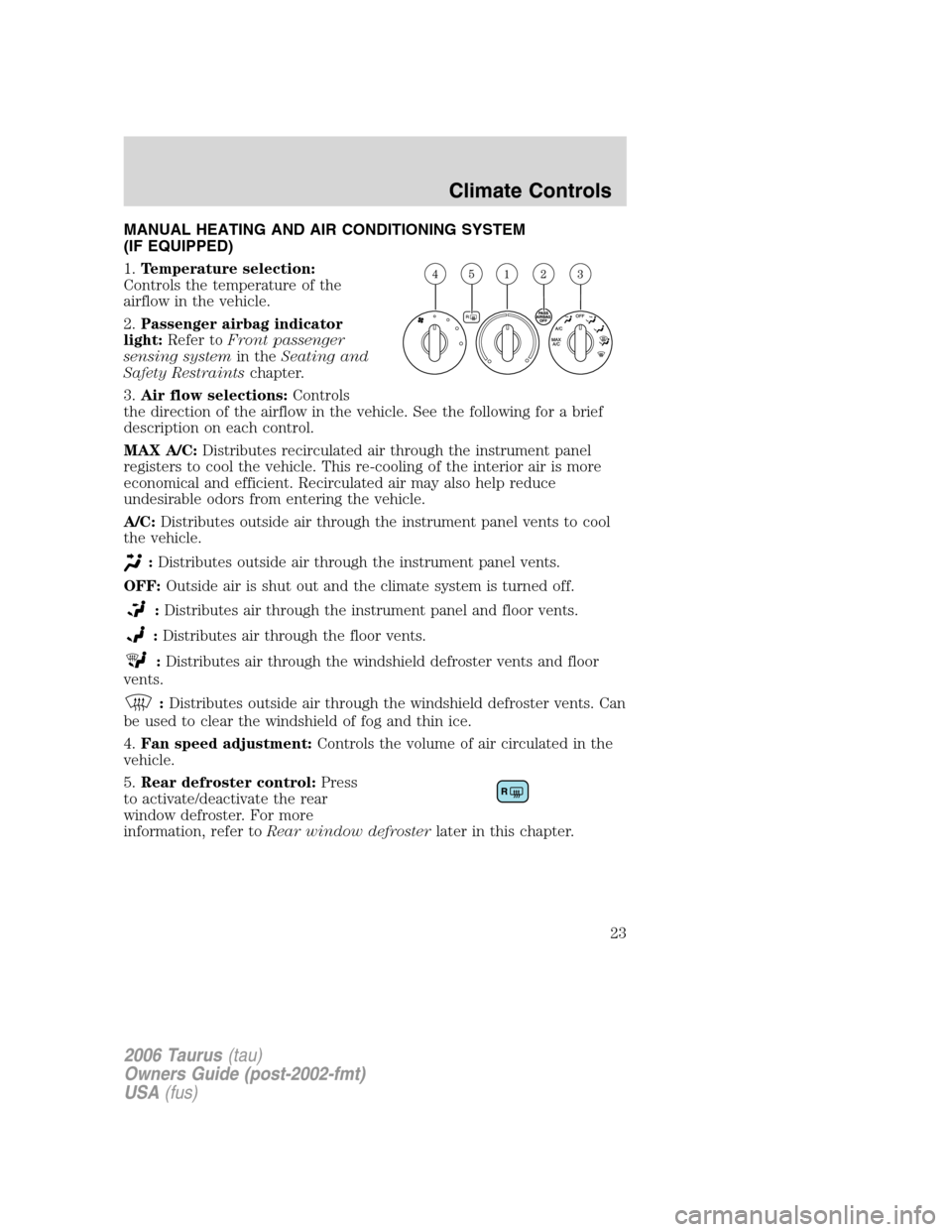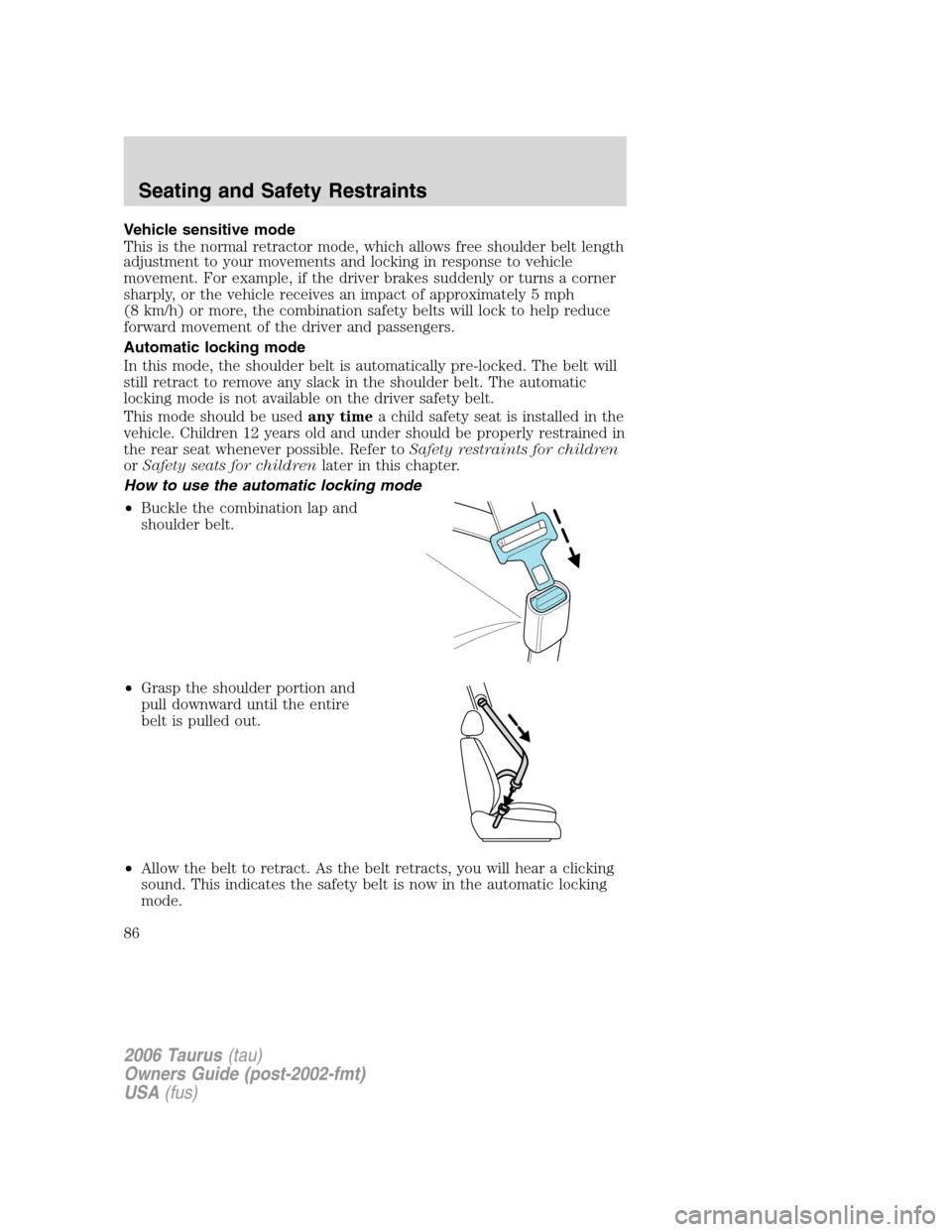2006 FORD TAURUS seat adjustment
[x] Cancel search: seat adjustmentPage 5 of 232

SAFETY AND ENVIRONMENT PROTECTION
Warning symbols in this guide
How can you reduce the risk of personal injury to yourself or others? In
this guide, answers to such questions are contained in comments
highlighted by the warning triangle symbol. These comments should be
read and observed.
Warning symbols on your vehicle
When you see this symbol, it is
imperative that you consult the
relevant section of this guide before
touching or attempting adjustment
of any kind.
Protecting the environment
We must all play our part in
protecting the environment. Correct
vehicle usage and the authorized
disposal of waste, cleaning and
lubrication materials are significant
steps towards this aim. Information in this respect is highlighted in this
guide with the tree symbol.
BREAKING-IN YOUR VEHICLE
Your vehicle does not need an extensive break-in. Try not to drive
continuously at the same speed for the first 1,000 miles (1,600 km) of
new vehicle operation. Vary your speed frequently in order to give the
moving parts a chance to break in.
Drive your new vehicle at least 500 miles (800 km) before towing a
trailer.
Do not add friction modifier compounds or special break-in oils during
the first few thousand miles (kilometers) of operation, since these
additives may prevent piston ring seating. SeeEngine oilin the
Maintenance and Specificationschapter for more information on oil
usage.
2006 Taurus(tau)
Owners Guide (post-2002-fmt)
USA(fus)
Introduction
5
Page 23 of 232

MANUAL HEATING AND AIR CONDITIONING SYSTEM
(IF EQUIPPED)
1.Temperature selection:
Controls the temperature of the
airflow in the vehicle.
2.Passenger airbag indicator
light:Refer toFront passenger
sensing systemin theSeating and
Safety Restraintschapter.
3.Air flow selections:Controls
the direction of the airflow in the vehicle. See the following for a brief
description on each control.
MAX A/C:Distributes recirculated air through the instrument panel
registers to cool the vehicle. This re-cooling of the interior air is more
economical and efficient. Recirculated air may also help reduce
undesirable odors from entering the vehicle.
A/C:Distributes outside air through the instrument panel vents to cool
the vehicle.
:Distributes outside air through the instrument panel vents.
OFF:Outside air is shut out and the climate system is turned off.
:Distributes air through the instrument panel and floor vents.
:Distributes air through the floor vents.
:Distributes air through the windshield defroster vents and floor
vents.
:Distributes outside air through the windshield defroster vents. Can
be used to clear the windshield of fog and thin ice.
4.Fan speed adjustment:Controls the volume of air circulated in the
vehicle.
5.Rear defroster control:Press
to activate/deactivate the rear
window defroster. For more
information, refer toRear window defrosterlater in this chapter.
2006 Taurus(tau)
Owners Guide (post-2002-fmt)
USA(fus)
Climate Controls
23
Page 86 of 232

Vehicle sensitive mode
This is the normal retractor mode, which allows free shoulder belt length
adjustment to your movements and locking in response to vehicle
movement. For example, if the driver brakes suddenly or turns a corner
sharply, or the vehicle receives an impact of approximately 5 mph
(8 km/h) or more, the combination safety belts will lock to help reduce
forward movement of the driver and passengers.
Automatic locking mode
In this mode, the shoulder belt is automatically pre-locked. The belt will
still retract to remove any slack in the shoulder belt. The automatic
locking mode is not available on the driver safety belt.
This mode should be usedany timea child safety seat is installed in the
vehicle. Children 12 years old and under should be properly restrained in
the rear seat whenever possible. Refer toSafety restraints for children
orSafety seats for childrenlater in this chapter.
How to use the automatic locking mode
•Buckle the combination lap and
shoulder belt.
•Grasp the shoulder portion and
pull downward until the entire
belt is pulled out.
•Allow the belt to retract. As the belt retracts, you will hear a clicking
sound. This indicates the safety belt is now in the automatic locking
mode.
2006 Taurus(tau)
Owners Guide (post-2002-fmt)
USA(fus)
Seating and Safety Restraints
86
Page 88 of 232

activated, the safety belt pretensioner for that seating position will be
activated if the seat belt is properly buckled.
The driver and front outboard passenger safety belt system (including
retractors, buckles and height adjusters) must be replaced if the vehicle
is involved in a collision that results in the activation of the safety belt
pretensioners. Refer to theSafety belt maintenancesection in this
chapter.
The driver and the right front passenger seat belt system
(including retractors, buckles and height adjusters) must be
replaced if the vehicle is involved in a collision that results in
deployment of front airbags or side airbags and safety belt
pretensioners.
Safety belt usage sensors
The driver and front outboard passenger safety belt buckles are
equipped with sensors that detect if the safety belts are fastened. The
sensors provide information to the Personal Safety System which can
then adapt the airbag deployment or safety belt pretensioner activation
based upon safety belt usage.
The Personal Safety System provides the most benefit to belted
occupants. The system monitors and tailors the air bag
deployment based upon safety belt usage. Failure to properly wear
your safety belt will increase your risk of injury.
Front safety belt height adjustment
Your vehicle has safety belt height
adjustments for the driver and front
passenger. Adjust the height of the
shoulder belt so the belt rests
across the middle of your shoulder.
To lower the shoulder belt height,
pull the control down and slide the
height adjuster down. To raise the
height of the shoulder belt, slide the
height adjuster up. To raise the
height of the shoulder belt from its
lowest position, pull the control down and slide the height adjuster up.
Pull down on the height adjuster to make sure it is locked in place.
2006 Taurus(tau)
Owners Guide (post-2002-fmt)
USA(fus)
Seating and Safety Restraints
88
Page 228 of 232

washing ....................................183
waxing .....................................183
wheels ......................................184
wiper blades ............................185
Climate control (see Air
conditioning or Heating) ............25
Clock adjust
AM/FM/Cassette ........................15
AM/FM/CD .................................18
Compass
zone/calibration adjustment ....56
Compass Display .........................55
Console ........................................42
Controls
power seat .................................79
Coolant
checking and adding ..............198
refill capacities ................202, 218
specifications ..................219–220
Cruise control
(see Speed control) ....................45
Customer Assistance ................154
Ford Extended Service
Plan ..........................................180
Getting assistance outside the
U.S. and Canada .....................181
Getting roadside assistance ...154
Getting the service you
need .........................................174
Ordering additional owner’s
literature .................................182
The Dispute Settlement
Board .......................................177
Utilizing the
Mediation/Arbitration
Program ...................................179D
Daytime running lamps
(see Lamps) ................................29
Defrost
rear window ..............................27
Dipstick
automatic transmission
fluid ..........................................215
engine oil .................................193
Doors
lubricant specifications ..........219
Driving under special
conditions ..................................153
through water .........................153
E
Electronic message center .........53
Emergencies, roadside
jump-starting ..........................168
Emergency Flashers .................155
Emission control system ..........212
Engine ................................220–221
cleaning ...................................184
coolant .....................................198
idle speed control ...................196
lubrication
specifications ..................219–220
refill capacities ........................218
service points ..........................191
starting after a collision .........155
Engine block heater .................144
Engine oil ..................................193
checking and adding ..............193
dipstick ....................................193
filter, specifications ........195, 217
recommendations ...................195
refill capacities ........................218
2006 Taurus(tau)
Owners Guide (post-2002-fmt)
USA(fus)
Index
228